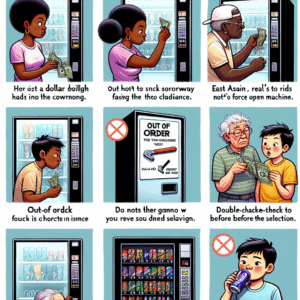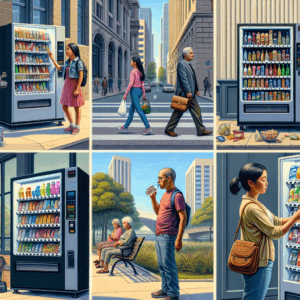Understanding Customer Needs
Researching Customer Preferences
Understanding your customers is step numero uno. The trick is to dive deep into their beverage and snack preferences. Are they more into the caffeine surge or the herbal tea mellow? Trust me, it’s worth conducting a survey or having some friendly chats to find out.
Once you’ve got the data, keep an eye out for trends. Maybe there’s a sudden spike in sparkling water fans. This insight helps tailor your vending stock to match consumer cravings, making your machines everyone’s go-to stop.
In my experience, directly talking to potential customers can be a game changer. It opens up more detailed desires such as wanting healthier options or ones that cater to specific dietary needs.
Identifying Typical Use Cases
Let’s think about where and when people usually use vending machines. Office workers, for example, might need a quick snack to power through the afternoon slump, whereas gym-goers might crave a post-workout protein bar.
Understanding these scenarios really helps in stocking the appropriate products and ensuring your machine is more than just another stop—it’s their best pal during the day.
This approach also allows you to tailor your marketing tactics. Considering how each group might use the machine plays into whether they give your service a thumbs up or not.
Gathering Customer Feedback
Feedback is your secret weapon. Setting up a simple way for customers to share their thoughts—be it through a QR code survey or a direct email line—can provide you with actionable insights.
I’ve often found that listening to what improvements customers suggest has led to some of the most positive changes in how I operate. Happy customers are repeat customers, after all.
And don’t ignore the negatives. Critiques are goldmines for innovation and improvement. Address them promptly, and your reputation will be golden.
Optimizing Vending Machine Locations
Selecting High-Traffic Areas
Location, location, location. Engaging in a bit of recon work to identify areas with a lot of foot traffic can drastically increase machine usage. Think busy office buildings, university campuses, or bustling shopping malls.
People are creatures of convenience. Place your machines where folks are naturally lingering or passing by, and you’ve got a recipe for success.
In my line of work, I usually pair this approach with eye-catching signage to make machines not just convenient but also irresistible. Bright colors and clear labels can do wonders.
Evaluating Competition
Competition isn’t just the spice of life; it’s a vital element of strategy. Do your homework and scope out local competition. What products do they offer? How are their prices?
I personally love a bit of healthy analysis here. You can always find ways to differentiate your service, whether through better pricing strategies, exclusive products, or enhanced machine tech.
Remember, it’s about making your offering the most compelling choice, and being aware of the competition is key in that equation.
Assessing Security Concerns
Vending machines can be targets for vandalism or theft, especially in less secure areas. Be sure to evaluate the safety of any potential location rigorously. Consult with property managers if needed.
I’ve found that investing in high-quality machines with security features such as shatterproof glass and alarm systems is often worth it in the long run.
Security isn’t just a nice-to-have; it’s crucial for maintaining operational efficiency and peace of mind, both for you and your customers.
Maintaining Inventory Effectively
Implementing a Stock Rotation System
Keeping your inventory fresh and appealing is no small feat. Implementing a FIFO (First In, First Out) inventory system helps to prevent the dreaded expired product scenario.
Over time, I’ve learned that regularly scheduled stock rotations ensure that products retain their appeal and guarantee a positive customer experience.
It’s all about consistent and reliable management, and it’s a skill that keeps the machine well-oiled and attractive to customers.
Utilizing Technology in Inventory Management
Gone are the days of manual monitoring. Leveraging technology like inventory software and smart vending machines can do wonders in keeping tabs on stock levels and popular items.
In my experience, adopting these tools not only saves time but dramatically minimizes human error. It’s like having a virtual assistant doing the grunt work for you.
And the tech doesn’t stop there—it can snitch on potential issues early, allowing for timely interventions before problems spiral out of control.
Tracking Sales Trends
Data is king. Pay attention to what sells and what lags. Analyze this data to adjust your restocking strategies and the types of products offered.
I’ve often capitalized on this by adding seasonal items and rotating stock to match evolving demand throughout the year.
Understanding sales trends allows you to stay light on your feet and make adjustments that keep customers coming back for more.
Providing Excellent Customer Support
Creating Easy Access to Help
Customers need to feel they’re supported. Offering multiple customer service touchpoints—such as phone support, email, or social media messaging—can make all the difference.
I’ve always found that being approachable is just as important as resolving issues quickly. That personal touch is what builds loyalty.
These channels also offer valuable feedback loops for further improvement, allowing a more refined service with each iteration.
Implementing Contactless Payment Options
In today’s fast-paced world, convenience is king. Adding contactless payment options to your machines not only speeds up transactions but also enhances user satisfaction.
I’ve frequently been told how this feature is a game-changer, especially for younger demographics who appreciate the convenience of just tapping to pay.
It’s a modest investment that can yield significant gains in user satisfaction and usage rate, making it a no-brainer.
Ensuring Timely Machine Maintenance
Nothing sours an experience like malfunctioning equipment. Prioritize frequent checks and timely maintenance to ensure machines are always in top shape.
From my standpoint, preemptive measures like regular cleaning and part replacements stop small issues from becoming bigger headaches.
This proactive stance not only minimizes downtime but also enhances the trust customers place in your service, making for a more reliable offering.
FAQs
1. Why is understanding customer needs important in vending machine services?
Understanding customer needs is crucial because it allows you to offer products that match consumer preferences, enhancing customer satisfaction and boosting sales.
2. How can optimizing vending machine locations increase sales?
By placing machines in high-traffic and secure areas, you maximize exposure and accessibility, encouraging more frequent use.
3. What role does technology play in inventory management?
Technology streamlines inventory tracking, reduces errors, and can provide real-time alerts, ensuring machines are well-stocked and efficient.
4. How does excellent customer support impact vending machine service?
Timely and approachable customer service fosters trust and loyalty, resolving issues quickly and improving the overall customer experience.



